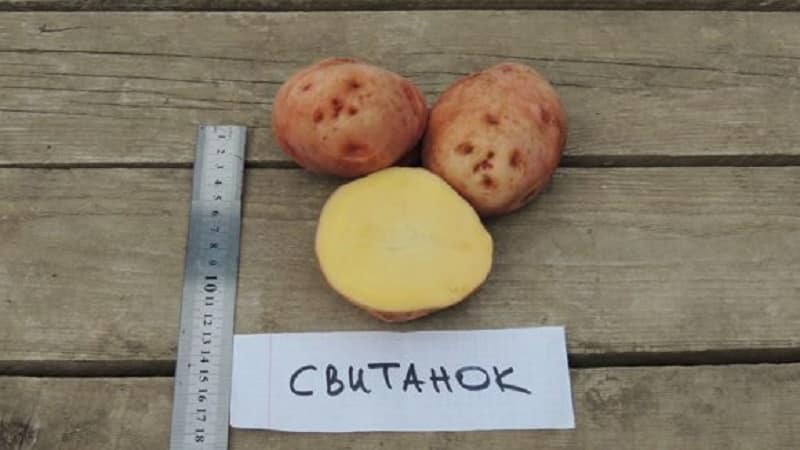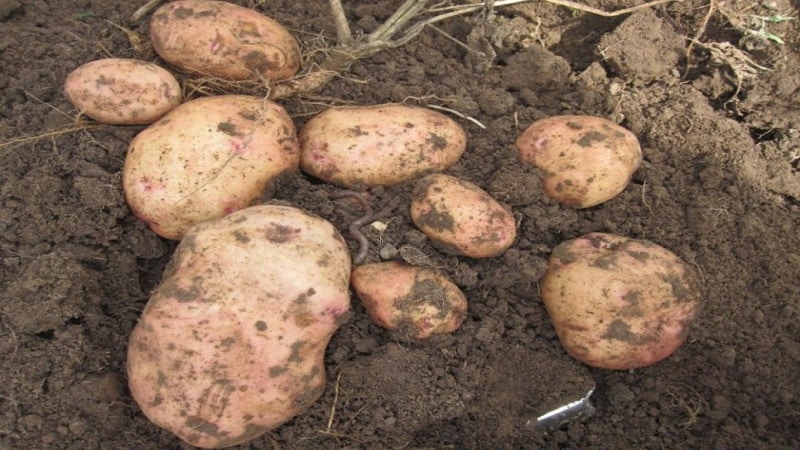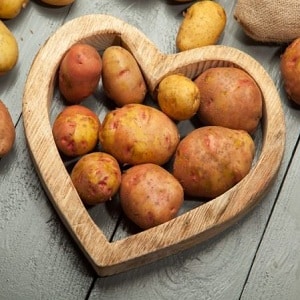A popular potato variety with excellent taste and good keeping quality “Kyiv Svitanok”
Svitanok Kyiv is a standard Ukrainian potato variety. Initially, the crop was bred for cultivation in temperate latitudes, but thanks to the successful adaptation of the variety to any type of soil and any weather conditions, it became possible to grow this potato in almost all regions of Russia. The medium-sized tubers have a pleasant pink skin and yellow pulp with a high starch content.
From the article you will learn the pros and cons of the variety, the nuances of agricultural technology, methods of combating late blight, wireworm and the Colorado potato beetle.
Description of the potato variety Kyiv Svitanok
Biologists from the Institute of Potato Growing of the Ukrainian Academy of Agrarian Sciences worked on the creation of the variety. The application for registration was submitted in 1982, and five years later, in 1987, the crop was included in the State Register of Breeding Achievements.
The variety was highly praised by farmers and is still considered one of the best, despite the variety of modern potato varieties and hybrids.
In the photo - Svitanok Kyiv potatoes.

The distinctive features of the variety are presented in the table.
| Indicators | Characteristic |
| Ripening period | 85-105 days |
| Bush | Low, erect, compact |
| Number of tubers in a bush | 8-12 |
| Weight | 90-120 g |
| Form | Oval-round |
| Coloring | The skin is thin, light pink, with deep eyes, the flesh is yellow |
| Leaves | Small size, dark green color |
| Corolla color | Red-violet |
| Starch content | 16-18% |
| Taste | 5 on a five-point system |
| Cooking class/group | C (very overcooked) |
| Productivity | 250-460 c/ha |
| Marketability | 96% |
| Keeping quality | 95% |
| Purpose | Tableware, more suitable for cooking and stewing |
| Sustainability | Immunity to cancer and black scab, average resistance to blackleg, common scab, viruses, susceptibility to late blight. |
| Transportability | High |
Chemical composition of potatoes
The table shows the vitamin and mineral composition of raw, unpeeled tubers.
| Name | Content | Norm |
| Beta Carotene | 0.001 mg | 5 mg |
| Vitamin B1 | 0.081 mg | 1.5 mg |
| Vitamin B2 | 0.032 mg | 1.8 mg |
| Vitamin B4 | 12.1 mg | 500 mg |
| Vitamin B5 | 0.295 mg | 5 mg |
| Vitamin B6 | 0.298 mg | 2 mg |
| Vitamin B9 | 15 mcg | 400 mcg |
| Vitamin C | 19.7 mg | 90 mg |
| Vitamin E | 0.01 mg | 15 mg |
| Vitamin K | 2 mcg | 120 mcg |
| Vitamin PP | 1.061 mg | 20 mg |
| Potassium | 425 mg | 2500 mg |
| Calcium | 12 mg | 1000 mg |
| Magnesium | 23 mg | 400 mg |
| Sodium | 6 mg | 1300 mg |
| Phosphorus | 57 mg | 800 mg |
| Iron | 0.81 mg | 18 mg |
| Manganese | 0.153 mg | 2 mg |
| Copper | 110 mcg | 1000 mcg |
| Selenium | 0.4 mcg | 55 mcg |
| Zinc | 0.3 mg | 12 mg |
Reference. The calorie content of raw potatoes is 77 kcal, boiled without salt - 86 kcal per 100 g.
Region for cultivation
The Svitanok Kyiv variety is adapted for cultivation on the territory of Russia in the Northwestern, Central, Middle Volga, Ural, Western Siberian, and Far Eastern macroregions.
Advantages and disadvantages
Advantages of the variety:
- increased amount of starch;
- reference taste;
- resistance to adverse climatic conditions;
- resistance to “potato” diseases;
- excellent presentation and keeping quality;
- high yield with minimal care.
According to farmers, there are no shortcomings in potatoes.
This is interesting:
How to get rid of warts using potatoes.
Do potatoes cause gas and why does it make your stomach swell?
Agricultural technology of culture
Svitanok Kyiv is grown on any type of soil, but the maximum result is obtained when planted in sandy loam soil, generously flavored with organic matter and minerals.
Planting care is minimal and does not require professional skills. It is enough to moderately water the bushes, hill up the beds, loosen the soil, remove weeds and apply organic and mineral fertilizers.

Preparing for landing
Three weeks before planting in the ground, selected tubers are taken out of the basement and placed in sunlight for germination. The material is treated with a pink solution of potassium permanganate and soaked in Fitosporin.
In practice, disinfectant liquid is often used:
- potassium permanganate – 1 g;
- boric acid – 10 g;
- superphosphate – 60 g;
- urea – 40 g;
- copper sulfate – 5 g;
- hot water (80°C) – 10 l.
The components are thoroughly mixed until completely dissolved and the tubers are soaked in a warm solution for 20 minutes.
Immediately before planting in the soil, the seed material is treated with germination stimulants “Zircon”, “Epin”, “Poteitin”, “Fumar”.
Timing, scheme and technology of planting
Potatoes are planted in the second ten days of April or the first ten days of May, depending on the climate. The soil temperature should be at least +7°C.
In the fall, the site is dug up and fertilized:
- organic — cow (50-100 kg per 100 sq. m) or horse (40-80 kg per 100 sq. m) manure;
- minerals - superphosphate (2 kg per 100 sq. m) or potassium chloride (1.5 kg per 100 sq. m).
A month before the intended planting, the area is sown with green manure (lupine, rye, wheat, peas, flax), then mowed and dug into the soil.Rotted greens loosen the soil, saturate it with air and prevent the growth of pathogenic fungi.
Seeds are planted to a depth of 10 cm, with an interval of 30-35 cm. The width between rows is 70 cm.
Place a handful of wood ash and potatoes with the sprouts facing up in each hole. Large tubers are cut into pieces and the cut is sprinkled with ash.
Reference. Tubers of the Svitanok variety are not prone to degeneration and loss of original qualities, so seed replacement is not required.
Care
To get a rich harvest, follow the rules of planting care:
- Potatoes Svitanok prefer moderate watering - once every 10-12 days. An excess of moisture leads to cracks in the tubers, and a deficiency leads to the death of the root system. The optimal solution is to install drip irrigation on the site.
- To prevent a hard crust from appearing on the surface of the earth, loosening is carried out after watering.
- Weeding begins seven days after planting.
- Hilling of the bushes is carried out twice: when the shoots extend 15 cm, and again during the flowering period.
- Harrowing is carried out on areas of more than three acres. A harrow is attached to the tractor or engine block, the teeth of which pull out weeds and deeply loosen the ground.
- Potatoes gain green mass more actively and form tubers if the bushes are fed with foliar fertilizers. For example, Finnish farmers reap a record harvest when applying foliar mineral fertilizers once every 10–14 days.
Recommended fertilizer application schedule:
- before flowering - 50 g of urea, 5 g of boric acid, 75 g of potassium monophosphate per 10 liters of water;
- during the flowering period - 20 g of superphosphate, 2 g of potassium chloride, 2 g of ammonium nitrate, 0.1 g of copper sulfate per 10 l;
- after flowering - 5 g of boric acid, 2 g of potassium permanganate per 10 l.
Advice. If the seedlings have been damaged by frost or hail, feed them with Zinc Chelate, Brexil, Reacom-SR-Potato fertilizers and growth stimulants Poteytin and Megafol.
Disease and pest control
The culture is immune to potato cancer and black scab, moderately resistant to blackleg, common scab and viruses, and susceptible to late blight.
Phytophthora reproduces by zoospores, which survive even in an unfavorable environment and quietly overwinter in the soil, plant debris, and on working tools. At an air temperature of +10°C and a humidity of 80-90%, spores germinate. The incubation period lasts from 3 to 16 days and is initially unnoticed. Then dark brown spots and a whitish coating on the back side appear on the leaves. Brown spots and traces of rot are visible on the tubers.
Late blight is almost untreatable, so the main emphasis is on preventive measures:
- crop rotation;
- sparse landing;
- pre-planting treatment of tubers in Fitosporin, potassium permanganate or copper sulfate;
- timely harvesting of tops and tubers;
- fertilizing with potassium-phosphorus fertilizers;
- treatment of plantings with Oxyx, Arcedil, whey with iodine.
Treatment:
- before flowering - “Artsedil” (50 g per 10 l), “Ridomil RC” (25 g per 10 l), “Oxychom” (20 g per 10 l).
- after flowering - “Ditamine M-45” (20 g per 10 l), “Kuproksat” (25 g per 10 l);
- 100 g of dry marsh horsetail, pour 1 liter of water, boil for half an hour and bring the volume to 5 liters, spray once a week;
- 1 kg of hay, a handful of urea per 10 liters, leave for 3-4 days, treat the bushes once every 14 days.
Colorado beetles like to feast on potato tops, and wireworms like to feast on tubers.
To combat the striped pest, use:
- insecticides “Aktara”, “Molniya”, “Apache”, “Korado”, “Commander”;
- dusting with corn flour, birch tar or gypsum on wet tops;
- decoction of celandine (fill a 10 liter bucket halfway with herbs, add water and boil for 30 minutes, cool and dilute with water 1:20);
- dandelion decoction (200 g of flowers and leaves, 250 g of horsetail, pour 10 liters of water, cook for 30 minutes, cool and dilute with water 1:5).
Agronomic practices are effective against wireworms:
- preliminary planting of peas, chickpeas, beans, mustard, clover, alfalfa, rapeseed, and buckwheat on the plot;
- frequent weeding;
- adding ash, eggshell powder, lime and chalk to the furrows when planting;
- planting onions, carrots, marigolds between the beds to repel beetles;
- autumn digging of the garden to a depth of 20 cm, which allows you to raise the larvae to the surface.
To destroy wireworm larvae, the products “Tabu”, “Prestige”, “Aktara” are used.
Features of cultivation and possible difficulties
The Kyiv Svitanok variety does not cause any difficulties with cultivation and shows high yields both with traditional and alternative planting. One of them is Igor Lyadov’s method (planting in closed beds), which saves time and effort on work.
Boxes without a bottom made of bricks or boards are constructed on the site. The height of the sides is 20 cm, the width is 1.1 m. The bottom is lined with straw, grass, hay or paper, compost and soil from the passages are laid on top. Subsequently, the passages are sprinkled with sawdust or straw for ease of movement on the site.
When planting potatoes, do not dig up the soil, since there is organic matter at the bottom that is undesirable to touch. They only loosen the soil. Two rows are formed inside the box, and the holes are placed at a distance of 30–40 cm.The landing is carried out in a checkerboard pattern. Ash, crushed chicken or quail egg shells are placed on the tubers and sprinkled with earth.
After small bushes appear, weeding and mulching with dry leaves or straw are carried out.
Collection, storage and use of crops

Harvesting is carried out in sunny, dry weather. The tubers are sorted, cleared of soil and laid out in one layer in a dark room to dry. Next, the potatoes are distributed into boxes or bags for further storage. The containers should not touch the floor, otherwise the potatoes will freeze on the icy floor. It is better to place them on elevated surfaces made of foam or brick.
The harvest is best stored with beets, which draw out excess moisture, preventing rotting. Apples are also placed in the boxes to protect the tubers from sprouting.
The optimal storage temperature in the cellar or on the balcony is +2-4°C, with a humidity of 70-80%.
The tubers are periodically sorted, discarding rotten and green ones.
Special “balcony cellars” will help preserve the harvest on a balcony or loggia with glazing. It looks like an ordinary large backpack that can be mounted on a wall or placed on a stand. In fact, such a cellar runs on electricity, maintaining the required temperature inside. Therefore, even if it is -40°C outside, the crop will not freeze.
Potatoes Svitanok Kyiv are ideal for making puree, which turns out appetizing and has a pleasant creamy color. Steaming will help preserve the structure. The tubers contain 16-18% starch, are non-watery, with a characteristic aroma.
Reviews
Reviews about the Svitanok variety are more than positive. Over the years of its existence, it has managed to win the love of farmers and consumers.
Ekaterina, Izhevsk: “Kyiv Svitanok is my favorite potato variety. I’ve been growing it for 10 years in a row and wouldn’t trade it for anything. I think that yellow potatoes are the most delicious, and I don’t plant varieties with white tubers on my plot. The crop is slightly inferior in yield to other modern hybrids and varieties, but the harvest is sufficient for personal use, especially since minimal care is required for the plantings.”
Maria, Rostov-on-Don: “I learned about this potato variety three years ago from a friend in Ukraine, where it is considered one of the best. I planted several bushes at the dacha and was pleased. The tubers are smooth, with pink skin and yellow flesh, just the way I like them. There are no special care requirements. To prevent late blight, I treat the planting material in copper sulfate, feed the bushes with potassium and phosphorus, and that’s enough.”
Read also:
Unpretentious in care and high-yielding potato variety "Agatha".
Conclusion
The Kyiv Svitanok variety has received high consumer appreciation over several decades due to its ease of cultivation, ability to adapt to any climatic conditions, excellent taste and not prone to degeneration.
The culture is resistant to viral diseases, cancer and scab, but is susceptible to late blight. Agrotechnical techniques (application of potassium-phosphorus fertilizers, preventive treatments with copper-containing preparations, whey with iodine), therapeutic spraying with “Artsedil”, “Kuproksat” help fight infection.